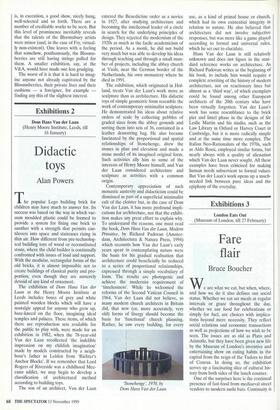Exhibitions 2
Dom Hans Van der Laan (Henry Moore Institute, Leeds, till 16 January)
Didactic toys
Alan Powers
The popular Lego building brick for children may have much to answer for. Its success was based on the way in which vac- uum moulded plastic could be formed to provide a system for fixing one brick to another with a strength that permits can- tilevers into space and staircases rising in thin air. How different from pre-technolog- ical building toys of wood or reconstituted stone, where the child builder is continually confronted with issues of load and support. With the modular, rectangular forms of the old bricks, it is almost impossible not to create buildings of classical purity and pro- portion, even though they are austerely devoid of any kind of ornament.
The exhibition of Dom Hans Van der Laan at the Henry Moore Institute at Leeds includes boxes of grey and white painted wooden blocks which will have a nostalgic appeal for anyone who grew up, bare-kneed on the floor, imagining ideal temples and palaces. These items, of which there are reproduction sets available for the public to play with, were made for an exhibition in 1982, when the 78-year-old Van der Laan recollected 'the indelible impression on my childish imagination' made by models constructed by a neigh- bour's father in Leiden from 'Richter's Anchor Blocks'. If we remember that Lord Rogers of Riverside was a childhood Mec- cano addict, we may begin to develop a classification of architectural method according to building toys.
The son of an architect, Van der Laan entered the Benedictine order as a novice in 1927, after studying architecture and becoming the intellectual leader of a circle in search for the underlying principles of design. They rejected the modernism of the 1920s as much as the facile academicism of the period. As a monk, he did not build very much but was able to develop his ideas through teaching and through a small num- ber of projects, including the abbey church at Vaals, near the German border of the Netherlands, his own monastery where he died in 1991.
The exhibition, which originated in Hol- land, treats Van der Laan's work more as sculpture than as architecture. His didactic toys of simple geometric form resemble the work of contemporary minimalist sculptors. He demonstrated his ideas about relative orders of scale by collecting pebbles of graded sizes from the abbey grounds and sorting them into sets of 36, contained in a leather drawstring bag. He also became fascinated by the proportional and spatial relationships of Stonehenge, drew the stones in plan and elevation and made a stone model of its imagined original form. Such activities ally him to some of the interests of Henry Moore himself, and Van der Laan considered architecture and sculpture as activities with a common origin.
Contemporary appreciation of such monastic austerity and didacticism could be dismissed as part of a superficial minimalist cult of the cloister but, in the case of Dom Van der Laan, it has more profound impli- cations for architecture, not that the exhibi- tion makes any great effort to explain why. To understand the reasons, one must read the book, Dom Hans Van der Laan, Modem Primitive, by Richard Padovan (Amster- dam, Architectura & Natura Press, 1994) which recounts how Van der Laan's early years spent in contemplating nature were the basis for his gradual realisation that architecture could beneficially be reduced to a series of proportional relationships, expressed through a simple vocabulary of form. The results are photogenic and achieve the modernist requirement of 'timelessness'. While he welcomed the reforms of the Second Vatican Council in 1964, Van der Laan did not believe, as many modern church architects in Britain did, that new (or, more accurately, very old) forms of liturgy should become the basis for 'functional' church planning. Rather, he saw every building, for every
Stonehenge', 1970, by Dom Hans Van der Laan use, as a kind of primal house or church, which had its own existential integrity in relation to nature. He also believed that architecture did not involve subjective responses, but was more like a game played according to formal and universal rules, which he set out to elucidate.
Hans Van der Laan is still relatively unknown and does not figure in the stan- dard reference works on architecture. As Richard Padovan writes at the beginning of his book, to include him would require a complete rewriting of the history of modern architecture, not on reactionary lines but almost as a 'third way', of which exemplars could be found among other European architects of the 20th century who have been virtually forgotten. Van der Laan's work has some resemblance to the brick pier and lintel phase in the designs of Sir Leslie Martin and his studio, such as the Law Library in Oxford or Harvey Court in Cambridge, but it is more radically simple and at the same time more complex. The Italian Neo-Rationalists of the 1970s, such as Aldo Rossi, employed similar forms, but nearly always with a quality of alienation which Van der Laan never sought. All these examples have been criticised for making human needs subservient to formal values. But Van der Laan's work opens up a much- needed link between pure ideas and the epiphany of the everyday.


























































































 Previous page
Previous page